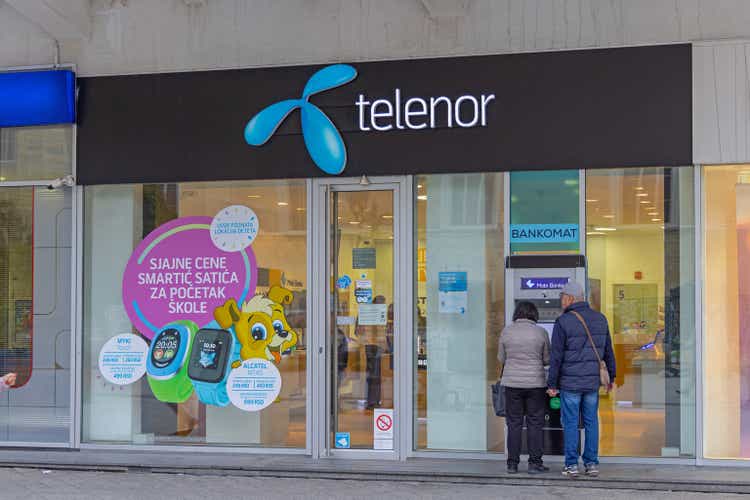Telenor Stock’s Frontier Exposure Is Not For The Fainthearted (OTCMKTS:TELNY)
Baloncici/iStock Editorial via Getty Images
Telenor (OTCPK:TELNY, OTCPK:TELNF), the once local Norwegian telecom company, has been transformed beyond recognition in the past 20 years, becoming a truly international operator with business in nine different markets in Northern Europe and developing Asia. Today, Telenor generates 65% of its EBITDA from emerging markets – high risk frontier markets for some – compared to a third generated from Northern European markets.
Telenor’s high exposure to emerging markets is not for fainthearted investors, it has been paying off. While the company generates an EBITDA margin of 62% from Bangladesh, 52% from Pakistan, and 50% from Malaysia – it only generates 41% in its home market of Norway and 40% from Sweden. Telenor’s Return on Capital Employed (RoCE) is also higher than European peers. Telenor takes significant risks through its emerging markets-focused business model, but it receives high returns to compensate for those risks.
Conservative financial policy is paying off
Telenor is unique among major European and US peers in boasting a solid credit rating of A-, compared to BBB+ and BBB for most peers. Telenor’s strong financial position has allowed it to distinguish itself from peers through another aspect; increasing dividends annually for the past five years. Compare this to Vodafone who has decreased its dividend pay outs, and BT which stopped it altogether for a couple of years, and Swisscom which has been paying the same dividend for the past five years.
The strong credit rating of Telenor is justified. Telenor’s management have been doing an admirable join keeping leverage levels subdued. Despite a drop in profitability in 2021, Telenor used its cash flows to reduce debt leaving Net Debt/EBITDA at a low of 1.9 times at the end of Q1 2022, and EBITDA/Net Interest Expense at a very comfortable 17.4 times. These efforts at keeping leverage levels below peers is wise, given the presence of Telenor in high risk emerging markets that generated 65% of profit before tax in 2021 – by far the highest exposure to emerging markets among major European and US peers. This wise policy of subduing leverage not only allowed the company to weather business shocks, such as the cessation of operations in Myanmar, but it also this conservative financial policy that allowed Telenor to continue raising dividends in the past years. Furthermore, the low leverage makes the company well positioned to navigate the brave new world of more and more expensive cost of debt.
Risks inherent in the business model
Three of the five emerging markets it operates in have had military coups in the past five years. This led to the closure of the write-off the business in Myanmar, incurring a write down loss of USD 780 million. It later agreed to sell the business to M1 group for USD 105 million, reducing slightly the losses. The political combined with economic pressures lead to the contraction of service revenues in both Thailand and Malaysia in the past four quarters. This led Telenor to consider merging its operations in both countries with competitors to achieve scale and improved market positions.
Lack of transparency and stability of regulation is another high risk in emerging markets, as some governments view telecom companies as the cash cows that should be squeezed whenever the chance allows. Telenor is facing various regulatory and tax disputes in Pakistan and Bangladesh.
And then the foreign currency risks and volatility are severe, and are not expected to get any better in the foreseeable future, with considerable pressures on emerging markets currencies due to the rising interest rates in major economies. Already before interest rates start rising in 2022, foreign currency losses reached USD 490 million in 2021, largely due to the significant depreciation of the Pakistani Rupee over the past year, which wiped out the operating profitability of Telenor Pakistan in 2021.
The high risks and continuous challenges that Telenor faces have kept its share price subdued for the past five years – today the share price is back to where it was in early 2017, leaving long-term investors to make their returns from the high dividend payouts.
Valuation is mid-range between peers
Telenor is trading at 4.5x market cap to operating cashflow. This lies mid-range between its European peers. On the low end, Vodafone is trading at 1.9x market cap to operating cash flow and BT at 3.2x. On the higher end, Dutch telecom company KPN is trading at 5.5x, and Swisscom trades at 6.75x.
The difference in valuation with peers does have its justification; Telenor recorded RoCE of 13% in Q1 2022, 10% in 2021 and 13% in 2020. KPN, with a higher valuation, recorded 11% in 2021 and 10% in 2020, while Vodafone on the lower end of valuation recorded 7.2% and 5.5%, in the comparable periods. Telenor maintains a high level of RoCE, almost double that of Vodafone, while maintaining a dividend yield of 7.2% – the highest among European and US peers.
Telenor exemplifies well what can be described as a high risk, high return investment. The disproportional high exposure to emerging markets versus developed markets provides high growth, high return on capital employed, high profitability and a high dividend yield. In return, risks such as arbitrary regulation and taxation, weakening foreign currencies of emerging markets and political risks are heightened in those emerging markets. For the risk averse investor, Telenor is too close to the sun, but for investors willing to trade higher returns for higher risks, Telenor is an investment worth considering.


